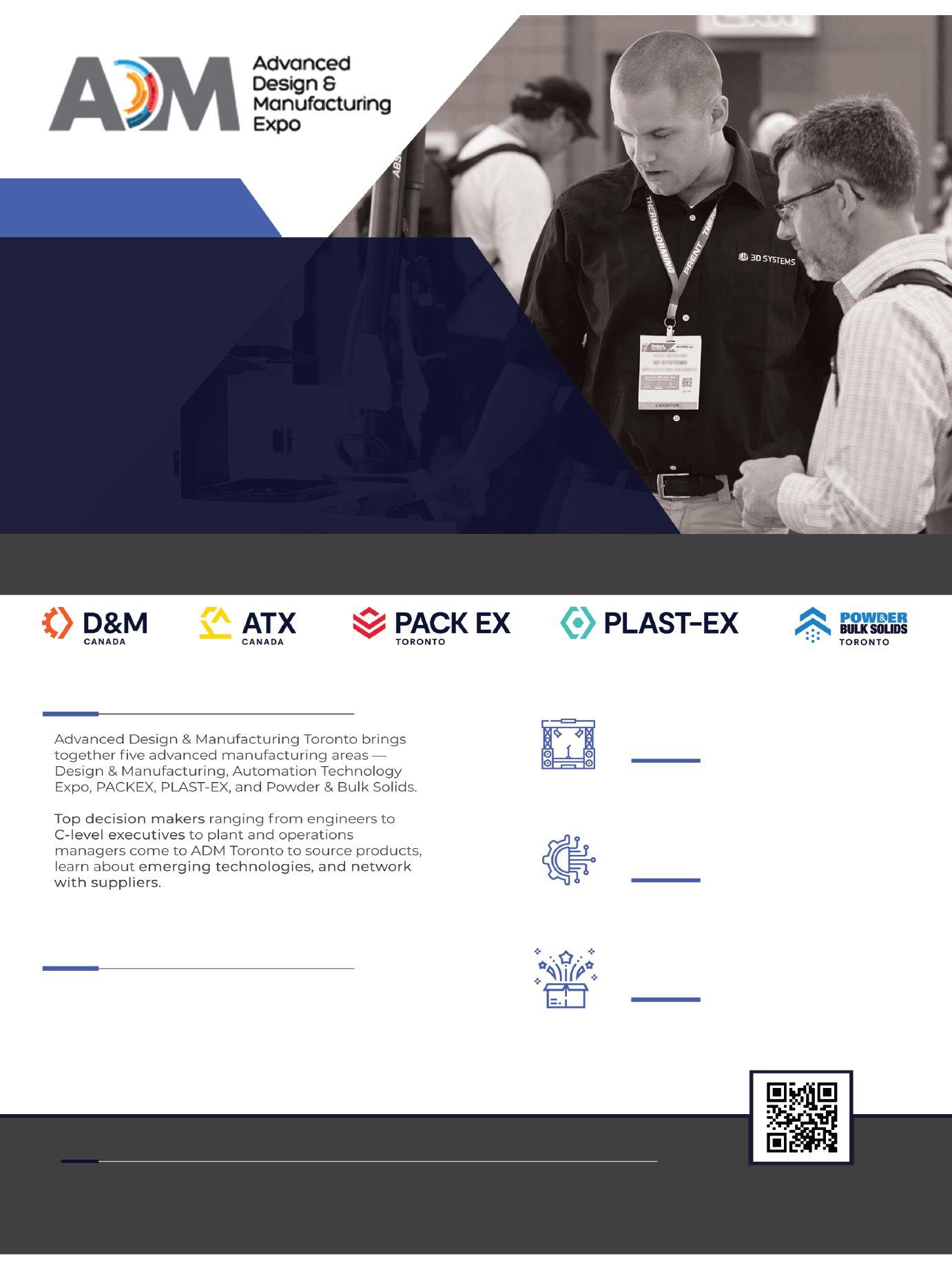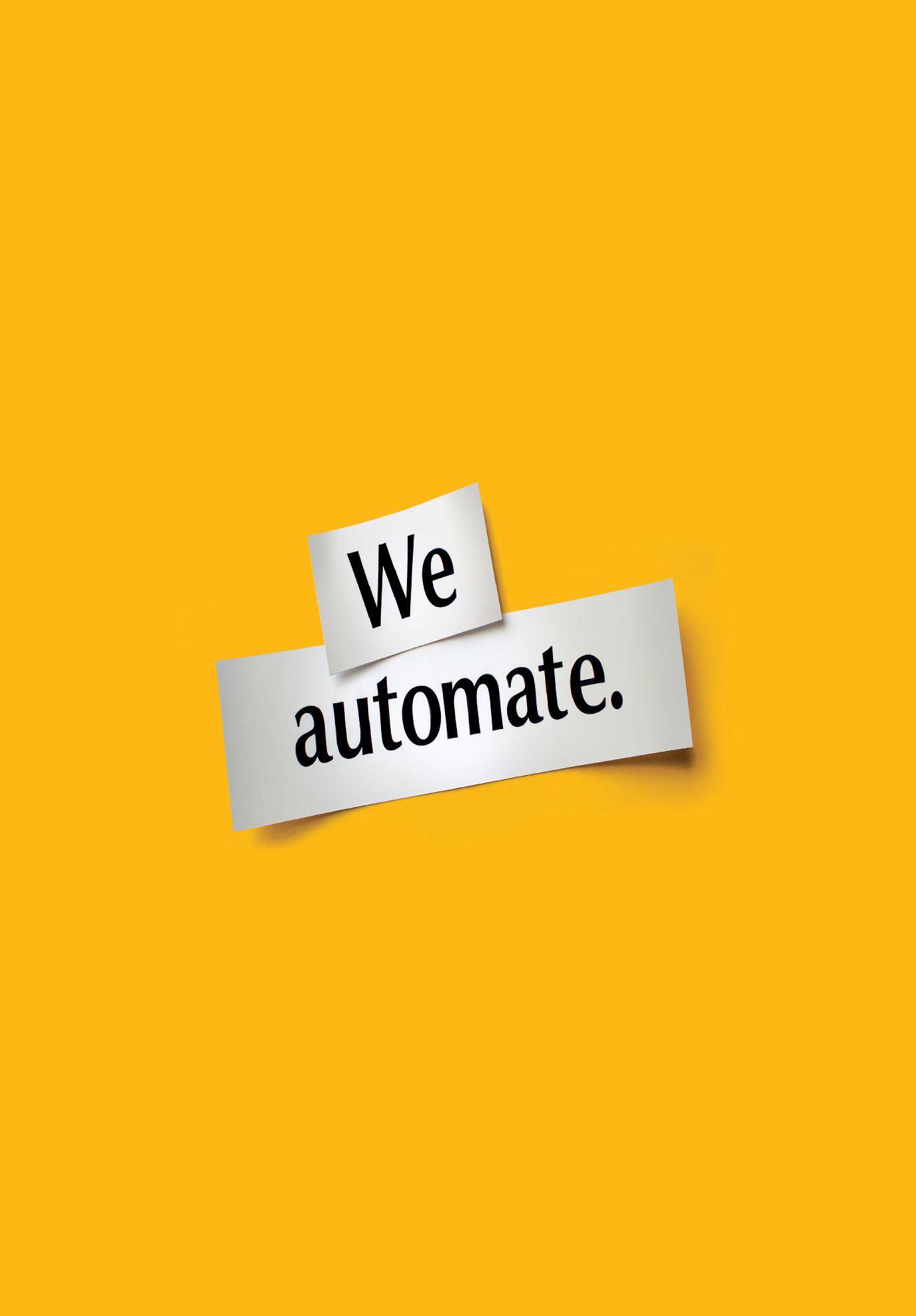DEMYSTIFYING ERP AND MES:
A short guide outlining the differences and benefits. p.8
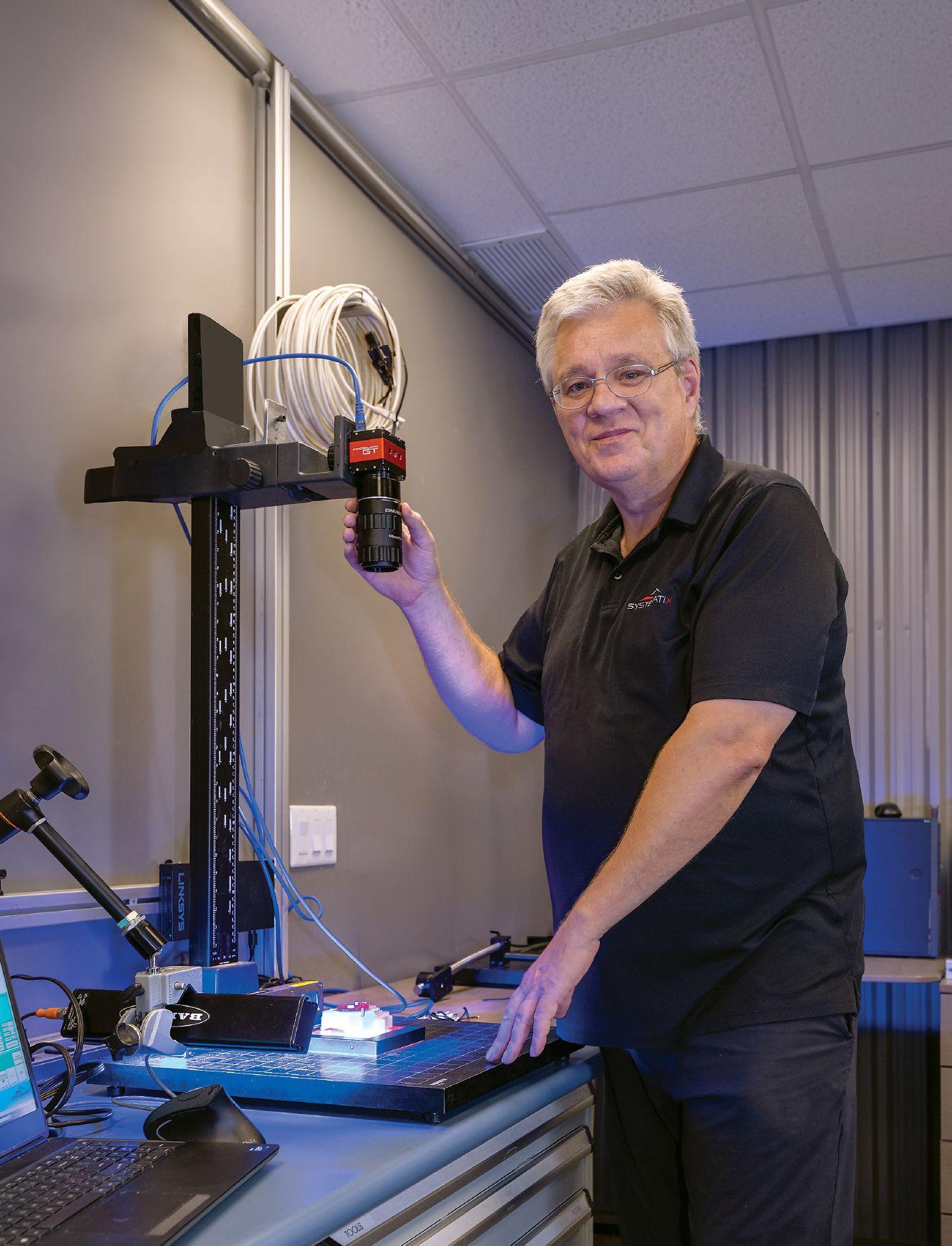

DEMYSTIFYING ERP AND MES:
A short guide outlining the differences and benefits. p.8

Navigating challenges to achieve results. p.14
ADDITIVE MANUFACTURING: Leveraging the technology in Canada. p. 16

Lifetime Achievement Award winner Michal Goc solves automation problems with innovative thinking and perseverance. p.10




NEW! WERMA eSIGN
Series LED Signal Towers

Starting at $388.00 (65700055)
WERMA eSIGN series signal towers provide full-surface signaling with a variety of programmable signal modes. The electronic modularity of these towers provides various colors, brightness levels, and light e ects, from the classic signal tower to completely customized settings. The eSIGN signal towers can also switch with ease between variable lling level indications and full-surface signaling.
• Available with 9 or 15 tiers
• Versatile customization options with different modes, light effects, and tones

In autoscale mode, the eSIGN segments are divided equally by the number of active status warnings. If only one status warning is active, the entire signal tower is illuminated in one color for maximum visibility.


•IO-Link v1.1 on select models
• Configurable via USB and the free configuration software, or IO-link on compatible models
Starting at $211.00 (HSST-3M2-RYG)
Filling level mode accurately indicates job progress or material availability as a percentage, gradually illuminating the signal tower from bottom to top or top to bottom.
















In signal tower mode, eSIGN segments are combined to create a classic signal tower. Individual tiers are assigned xed positions that are turned ON when their corresponding status bit is active.



























Patlite® HSST Series Signal Tower Station

PATLITE HSST series signal tower stations o er a low-cost solution for controlling the stack light colors manually via an included 3-button switch box and power adapter.
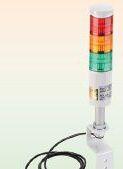
Starting at $7.50 (ECX2070-24)
Audible signal horns and buzzers featuring:
• Indoor / Outdoor models up to 110 dB
• Selectable alarm tones
• Hazardous location rated alarms










Research, price, buy at: www.automationdirect.com/stacklights www.automationdirect.com/audible-alarms







All tiers, colors, light e ects, and sounds are con gured independently for each signal tower state in individual mode. Each signal tower state is selected based on the combination of active status inputs, allowing for a maximum of 64 possible states.




Patlite® LKEH Series - 100mm Combination
Large Light Tower and Horn Starting at $445.00 (LKEH-102FEUL-R)

Patlite LKEH series 100mm LED signal towers feature a large signal horn and light tower combination, ultra-bright LEDs with a 100mm lens, and an alarm volume up to 105 dB.
• 32 alarm tones
• 1 to 4 LED tiers (modules)
• Select models with IP69K protection rating Also Available
Patlite® 70mm LS7 Series
Starting at $162.00 (LS7-302DWC-RYGNN)








Patlite® LS7 series 70mm signal towers o er an attractive smooth body design with no screws or metal parts exposed, excellent for harsh environments and areas where high pressure/temperature washdowns are required.
• Available in 3 or 5 LED tiers
• Models with buzzer available




Our shipping policies make it easier than ever to order direct from the U.S.!
Fast free standard shipping* is available for most orders over $49 U.S., and that includes the brokerage fees (when using an AutomationDirect nominated broker). Using our choice of carrier, we can reach most Canadian destinations within 2 to 3 days.



*Free shipping does not apply to items requiring LTL transport, but those shipments can take advantage of our negotiated super-low at rates (based on weight) that include brokerage fees.
See Web site for details and restrictions at: www.automationdirect.com/canada













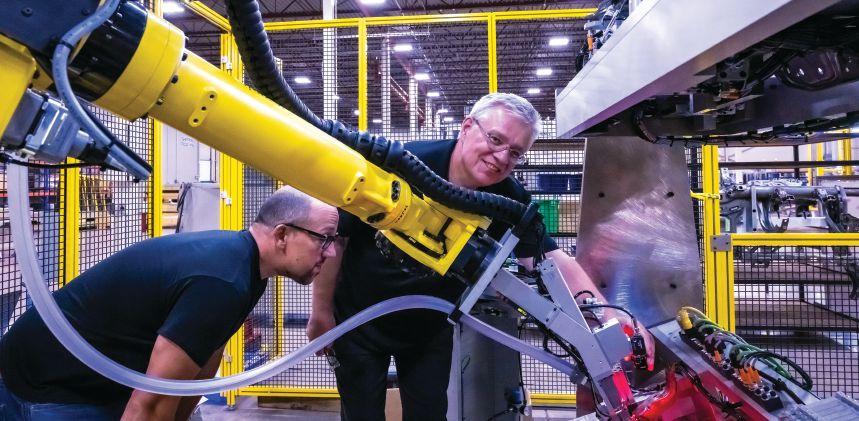



Lifetime Achievement Award winner Michal Goc solves challenging automation problems with an innovative mind and perseverance.
By Sukanya Ray Ghosh
Navigating
when implementing robots to achieve desired results.
By Sukanya Ray Ghosh
Opportunities
leveraging additive manufacturing and 3D printing technologies in Canada.
By Sukanya Ray Ghosh
Latest vision and artificial intelligence capabilities are allowing small and medium-sized manufacturers to respond rapidly to changing market conditions.
By Sukanya Ray Ghosh


BY SUKANYA RAY GHOSH
Robotics, like most automation technologies, has evolved over the past few decades to address crucial changes in the market, including changing customer demands and growing challenges for manufacturers. If recent studies, reports and surveys conducted by different organizations, including McKinsey & Company, International Federation of Robotics (IFR), Association for Advancing Automation (A3) and Interact Analysis, are to be believed, robotics is one of the most rapidly growing segments and widely adopted technologies.
However, the McKinsey report finds that many industry executives remain wary of adopting robots and automation technologies. Cost of hardware and a lack of internal experience are their top concerns.
The report goes on to say that industrial companies need to ensure that they get the implementation right. Therefore, the most successful solution providers will be the ones that can help companies overcome challenges, “including those related to technology selection, implementation planning, and acquisition of the skill set required for rollout on a larger scale.”
Robot sales have seen a mostly upward growth trajectory in North America, as per recent A3 and IFR reports. What has facilitated this increase in adoption? It probably has something to do with how robotics technology has transformed to meet the most pressing needs of the market.
The typical traditional industrial robots have existed in manufacturing settings for several decades. The robots today use artificial intelligence, machine learning and other such advanced technologies to perform increasingly more complex tasks. From my most recent conversations with industry








professionals, it is apparent that collaborative robots (cobots) are highly sought after, especially when the budget is tight but automation is necessary. Autonomous mobile robots (AMRs) are also popular for logistics and material handling automation on factory floors.
The innovations in the robotics space keep coming. Just recently, Festo, in collaboration with Canadian and German partners, successfully demonstrated how a distributed AI method can train robots for pick and place operations without sensitive data exchange. The robot arms in the picking cells are equipped with cameras to visually detect the items in front of them.
What comes next? A robot that walks the factory floors like a human? If current news reports on the existence of biped humanoid robots are to be believed, then yes. Apptronik, an innovator in this space, recently unveiled Apollo, its general-purpose, AI-powered humanoid robot. According to the company, it is built to work in environments designed for, and directly alongside, humans. Apollo will reportedly operate in warehouses and manufacturing plants in the near term.
This news does not come as a surprise, given that automation is headed towards the Industry 5.0 era of human-machine collaboration. However, it does not mean that we will be seeing mass adoption of humanoid robots in manufacturing facilities right away. There are still a lot of opportunities for the adoption of traditional robots, cobots and AMRs, even when these options have been in the market for a while now. The existence of humanoid robots simply confirms that human beings will not cease to innovate to try to improve the workspace further.
What type of robot is currently on your digital transformation wish list? | MA
Your resource for Canada’s industrial automation news
Reader Service
Print and digital subscription inquiries or changes, please contact customer service
Angelita Potal
Tel: 416-510-5113
Fax: (416) 510-6875
email: apotal@annexbusinessmedia.com
Mail: 111 Gordon Baker Rd., Suite 400 Toronto, ON M2H 3R1
EDITOR
Sukanya Ray Ghosh srayghosh@annexbusinessmedia.com Tel: 416-510-5225
ASSOCIATE PUBLISHER
Kathryn Swan kswan@annexbusinessmedia.com Tel: 647-339-4880
GROUP PUBLISHER
Paul Grossinger pgrossinger@annexbusinessmedia.com
MEDIA DESIGNER
Graham Jeffrey gjeffrey@annexbusinessmedia.com
ACCOUNT COORDINATOR
Debbie Smith dsmith@annexbusinessmedia.com Tel: 416-510-5107
AUDIENCE DEVELOPMENT MANAGER
Urszula Grzyb ugrzyb@annexbusinessmedia.com 416-510-5180
PRESIDENT/COO
Scott Jamieson sjamieson@annexbusinessmedia.com
CONTRIBUTING WRITERS
Paul Hogendoorn and Stephanie Holko
Published by Annex Business Media 111 Gordon Baker Rd., Suite 400, Toronto, ON, M2H 3R1 Tel: 416-442-5600 • Fax: 416-442-2191
Printed in Canada ISSN 1480-2996
Publication Mail Agreement #40065710
SUBSCRIPTION RATES
Canada — $43 per year
United States — $75.50 (US) per year
Foreign — $86 (US) per year
Students — $20.50 per year
ANNEX PRIVACY OFFICER email: privacy@annexbusinessmedia.com Tel: 800-668-2374




@AutomationMag srayghosh@annexbusinessmedia.com /company/automation-mag






EDITORIAL ADVISORY BOARD






JIM BERETTA, President, Customer Attraction and host of The Robot Industry Podcast
JONATHAN GROSS, Managaing Director, Pemeco Consulting
MIHAELA VLASEA, Associate Professor, Department of Mechanical and Mechatronics Engineering and Research Co-Director, Multi-Scale Additive Manufacturing Laboratory at the University of Waterloo
SHELLEY FELLOWS, Chair, Automate Canada
STEPHANIE HOLKO Director, Project Development at Next Generation Manufacturing Canada
WALTER GARRISON, Former Advanced Manufacturing Business Consultant for City of Mississauga












Occasionally, Manufacturing AUTOMATION will mail information on behalf of industry related groups whose products and services we believe may be of interest to you. If you prefer not to receive this information, please contact our circulation department in any of the four ways listed above. The contents of Manufacturing AUTOMATION are © 2023 by Annex Business Media and may not be reproduced in whole or part without written consent. Annex Business Media disclaims any warranty as to the accuracy, completeness or currency of the contents of this publication and disclaims all liability in respect of the results of any action taken or not taken in reliance upon information in this publication.





















The manufacturing sector of Canada’s defence and security industry is a tightly-knit supply chain protecting us from threats. From micro devices to massive machines, Canadian companies work together to deliver value and make our country stronger. Discover a network of opportunities and a community with real purpose.















Advanced Motion & Controls opens new location in Mississauga
Advanced Motion & Controls recently opened its new location at 1081 Meyerside Dr, Unit 13, Mississauga, Ontario. The company explains in a press statement that this strategic expansion underscores its commitment to better serve its customers while strengthening its position as a premier player in the industrial automation components industry.
The new facility offers features that will enable Advanced Motion & Controls to enhance its service offerings and streamline its operations. The larger space will provide access to technologies such as robotic welding, palletizing, vision inspection and feeding systems as well as an inventory of electronic, pneumatic and mechanical components. The facility has also been designed to facilitate on-site training and offers a modern collaboration space to foster customer interaction with its sales and technical staff.
Pilz Canada marks 10 years in Canada with celebratory cruise
On July 31st, Pilz Canada marked ten years of operation in Canada with a boat cruise on Lake Ontario for its employees, clients and key partners.
The cruise was well attended, with 60 people on board to enjoy the evening and commemorate the milestone. The occasion was marked by the attendance of key dignitaries including Pilz General Manager and CEO, Andreas Sobotta, the Consul General of Germany in Toronto (former), Thomas Schultze, as well as Susanne Kunschert and Thomas Pilz, part of the ownership group of Pilz.















Manufacturing AUTOMATION caught up with Thomas Pilz and Susanne Kunschert to discuss the automation technology company’s journey over the last ten years.
The ownership pair were asked to expand on their slogan, ‘We want to work not just with one another, but for one another’ and what this meant to them, and how this manifests at the safety and automation tech company every day.
“This means that we’re a complete team, working together with openness and transparency. During COVID-19, this was difficult, but now that people are coming back into the office, we know each other, and we’re getting to work together and build a culture that has a willingness from everyone put the team’s and client’s needs first,” said Susanne Kunschert.
The leaders were asked to weigh in on some of the future challenges they would navigate in the near-term.
“I think it’s going to be the supply chain. This will create the next great challenge for us to overcome. We’re fortunate that Germany and Canada have a great business relationship with each other. We’re dealing with a system where the supply chain is fractured, with countries being less reliant on China, so we’ll have to establish a more resilient, flexible supply chain that brings manufacturing back to Canada,” said Thomas.
Festo successfully completed its FLAIROP (Federated Learning for Robot Picking) research project that was aimed at making picking robots more intelligent using distributed AI methods.
Festo has been conducting joint research with the “Karlsruher Institut für Technologie” (KIT) and partners from Canada – University of Waterloo and Darwin AI. The partners investigated how robots can learn from each other without sharing their training data. This approach – called “federated learning” –allows to develop more robust and efficient AI than it would be possible with data from just one robot – without handing out sensitive company data.
Festo explains in a press statement that “federated learning” is a machine learning technique
to create privacy-preserving AI applications. Instead of sending the training data of the robotic arms in the picking cells to a central server to train the model there, the training takes place at many different locations. The locally trained models are then sent to the central machine learning server so that the sensitive training data does not leave the data provider. “Federated learning” reportedly enables learning across data silos by aggregating the distributed models and enabling highly accurate and data-driven prediction of object recognition and grasping point detection.
The robot arms in the picking cells are equipped with cameras to visually detect the items in front of them. Based on the camera image, the robot arms automatically recognize the different items and select a suitable gripping method.
Weidmuller Canada joins AD Electrical –Canada
Weidmuller Canada is now part of AD’s Electrical – Canada division. A manufacturer of connectivity solutions, Weidmuller offers a diverse range of products, solutions and services for smart industrial connectivity and the Industrial Internet of Things.
Weidmuller has been integrated into the AD Electrical – Canada network from August 1 onwards. The AD network is a
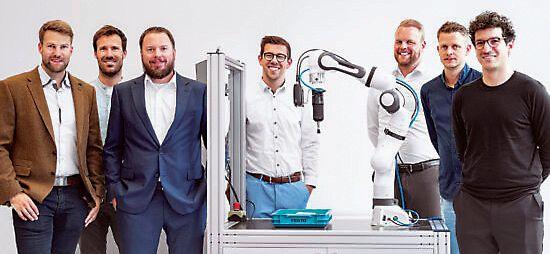
marketing and buying group for industrial and construction supplies in North America. The AD distributor network is reportedly well-positioned to market Weidmuller’s wide range of offerings, including terminal blocks, power supplies, relays, I/Os, heavy duty connectors, signal conditioning, ethernet product classifications, and many more, throughout the Canadian marketplace.
Dates: September 25 –28, 2023
Location: Toronto Congress Centre, Toronto, Ontario
The 2023 Canadian Manufacturing Technology Show (CMTS) will feature more than 200 cutting-edge innovations in advanced manufacturing including additive manufacturing, automation, robotics and digital transformation. Thought leaders will provide over 50 education sessions, where attendees will gain invaluable insights into the latest trends and advancements shaping the manufacturing landscape. CMTS 2023 will also feature the CTMA Tooling Pavilion, CWB-EWI Showcase, MaRS & NGen Discovery District and The Smart Theatre.
Dates: October 26 and November 16, 2023
Locations: Living Arts Centre, Mississauga, Ontario and Courtyard Montreal Airport, Montreal, Quebec
With 22 exhibitors, this year’s German Technology Days (GTD)
trade shows will be the place to see the latest technology releases from German companies in the Canadian marketplace. From the latest in AI, machine learning led tools, to the solutions of manufacturing, automotive, robotics, building automation, smart city automation, safety and more that solve the biggest challenges facing the industry today, GTD2023 in Mississauga and Montreal will have it all. The exhibition hall will feature factory, logistics and process automation and will be open the entire day to all registered attendees. Technical representatives will be onsite to answer any questions about applications and solutions. The theme for GTD2023 is “Transformation – Elevating your potential with automated solutions.” All exhibiting companies will offer educational presentations aligned with the theme.
Dates: November 7 – 9, 2023
Location: Toronto Congress Centre, Toronto, Ontario
Advanced Design and Manufacturing Expo Toronto (ADM Toronto) returns to the Toronto Congress Centre this November 7-9, 2023. ADM Toronto is a major end-to-end conference and exhibition driving exploration into the latest trends and technological advances in the design and manufacturing industries.
This biennial three-day expo which alternates years with ADM Montréal, is comprised of five advanced manufacturing areas – Design & Manufacturing, Automation Technology Expo, PACK EX, PLAST-EX, and Powder & Bulk Solids. This year’s
event will showcase the latest trends and technologies shaping the future in advanced design and manufacturing.
The comprehensive agenda caters to all five sectors of manufacturing through over forty education sessions covering a range of key topics from artificial intelligence, packaging and automation trends, EV supply chains and plastics sustainability. Keynote speakers include John Laughlin, chief technology officer at NGen and Rocco Rossi, president of the Ontario Chamber of Commerce. The expo floor will highlight over 300 exhibitors.
The 2023 show will feature the all-new EV Pavilion, highlighting the top manufacturers and innovations in electric vehicles for the first time ever in Canada. Registered guests will
have access to a full EV Battery conference slated for November 8 and 9 with session topics including EV battery manufacturing, battery design innovation and EV infrastructure.
“Thanks to our world-class manufacturing and technology clusters, including leading firms in areas such as artificial intelligence, systems integration, automation and machine learning, Canada is a global leader in the field of advanced manufacturing. The federal government is proud to partner with sector leaders like you, as well as the research centres and post-secondary institutions that enable the development of our next generation of manufacturing technologie,” says François-Philippe Champagne, P.C., M.P., Minister of Innovation, Science and Industry. | MA

BY PAUL HOGENDOORN
Paul Hogendoorn co-founded FreePoint Technologies with the goal of giving manufacturers the benefit of information technologies that inform, empower and motivate their most critical asset – their people. He can be reached at hogendoorn.paul@gmail.com or linkedin.com/in/paulhogendoorn.
Manufacturers are being overwhelmed by the introduction of three and four-letter acronyms that describe things they are said to need to adopt and incorporate into their companies to have any chance of surviving into the future – such as ERP, MES, IIoT, Industry 4.0, smart manufacturing and digital transformation, and so on.
Manufacturers deliver goods every day and every week of every year. It’s on time, or it’s late. There is no “substantially complete” or “almost done” or “nearly on time.” It’s done or it’s not, it’s on time or it’s late. It works or it doesn’t. That’s the manufacturers’ world –real, tangible and tactile. They deliver a good product that does what it’s supposed to, on time, with a warranty, and for a competitive price. If they do all that, they stay in business and earn the opportunity to meet their customers’ demands tomorrow. And if they don’t, they’re out of business. So, whenever a manufacturing company leader asks me about these new terms or fuzzy topics, I remind them that the smartest people in the room is them. Whatever technology they choose to adopt should be on their terms, to suit their purposes and to fit their processes.
Many manufacturers don’t know what the new terminology means, or how it really applies to their business. They often feel at least a small level of insecurity because of that, which causes them to delegate critical investment of time and money decisions to people who know technology (or the new technology terminology) but not the actual processes or products. Delegating the selection of new technology completely to technology-knowledgeable people instead of manufacturing-knowledgeable people usually costs the company not only money but also time.
Here’s an “everything you wanted to know about technology but were afraid to ask” list of questions I get asked most often.
Q: What is the definition of ERP?
A: “Enterprise resource planning” software allows the management of all the information and resources involved in a company’s operations by means of an integrated computer system.
Q: What is the definition of MES?
A: “Manufacturing execution systems,” are















computerized systems used in manufacturing to track and document the transformation of raw materials to finished goods.
Q: What is the difference between ERP and MES?
A: An MES tracks and collects information about each product through all stages of the production process. An ERP is an integrated suite of software applications that business managers can use to run almost every aspect of their organizations. An ERP may include an MES module, or an MES can be a standalone software.
Confused yet? If you are a technology person, it probably makes sense, and the differentiation may be as simple as this: MES systems are typically connected to machines and measure processes while ERPs typically measure the activity of the jobs. MES systems measure against a fixed efficiency target (OEE for example) while ERP systems measure actual against planned time and targets for each job.
If you are a production-focused person in a high mix, low volume operation, it usually comes down to getting jobs done according to what was planned. Did you deliver what was planned for, when it was planned? Success means being able to answer both of these questions with “yes”; failure is not being able to answer both questions with “yes.” Technology people suggest that you should use the ERP system to answer the two “yes-no” questions (did you deliver what was planned when it was planned?) and an MES system to give you more insights and data to refine and optimize your processes to make sure you get “yes-yes”
answers more often in the future.
But, why two different but heavily overlapping systems? And where should things like bills of materials, work instructions, production schedules and checklists reside? The biggest reason this ambiguity is a major concern for many manufacturers is the cost and time associated with deploying either an ERP system or an MES system. It’s important to get the deployment – whichever you choose to do first – right.
Q: Why are there two different systems in the first place?
A: ERP systems evolved from MRP (material requirement planning), which was created more from an accounting and administration perspective than an actual machining and production perspective. MES evolved from machine monitoring, which was driven from an engineering and machine efficiency measurement perspective. One started out as a tool for administration, procurement and planning, and the other started out as an engineering and maintenance tool for machine monitoring, process improvement and downtime reduction. As they both continue to evolve and expand, there is now a lot of functional overlap.
Q: What should a manufacturer do first – ERP or MES?
A: MES systems are generally far less expensive and far easier to implement than ERP systems and there is far less disruption and inconvenience to the day-to-day operation of the business. MES systems are generally priced in the tens of thousands of
dollars range and can be fully deployed in weeks while ERP systems are often priced in the hundreds of thousands of dollars range and routinely take six months to a year to get fully deployed. MES systems typically deliver actionable insights within 60 to 90 days. If those insights are acted upon, the return on investment is very short, sometimes within 90 days.
M ES systems are great for engaging production personnel and feeding empirical information into a company’s CI (continuous improvement) team and process. Although the ERP investment is bigger, is often disruptive and takes more time, it has one significant and important advantage. An ERP system can provide visibility on the primary metric that matters most: Is the work getting done when it’s supposed to be done at the cost at which it was expected to be done? An ERP should be able to answer that question for you, while MES systems provide typically indirect metrics and measurements of success, such as uptime, runtime, OEE and opportunities for process improvement (downtime).
So, which one should you do first? It depends on what you see as your biggest need in your business. Some companies have adequate production planning and administration systems already in place. So, starting with an MES system would make sense. Others don’t have the financial visibility and accountability on a product-by-product or project-by-project basis, and that lack of certainty is affecting their ability to win business or know what part of their business they should grow (or let go). In that case, an ERP would make sense.
In short, ERPs focus on the products being produced and the costs and resources involved; MES on the other hand places a focus on the machines and various plant-floor level processes, looking to improve efficiencies of the machines and processes. In a steady-state production facility (where the same products are continuously run, processed or packaged), an MES system may be the most beneficial investment to make. In a custom job shop, where the company produces single or low volumes of complex products, an ERP may be of more benefit. Some companies start with an MES because it’s less expensive and easier to implement, use the visibility to drive engagement and productivity, and then use the data and insights to better focus and measure their continuous improvement efforts, while taking the extra time to make sure they make the right ERP decision.
No one knows your business as well as you.
As a LEAN colleague of mine always says: “People first, process second, and technology third.” Expensive technology doesn’t always make your business better, especially if it doesn’t fit your processes, and doesn’t work for your people. From a LEAN perspective, whatever does not add value to your customer is considered waste, whether that’s in
administration, engineering or production. Your technology choices should be focused on what delivers the most value to your customers – now, and in the future. What tools make your people better, your processes better and your product better? The question is not really about technology at all – it’s all about your business. | MA
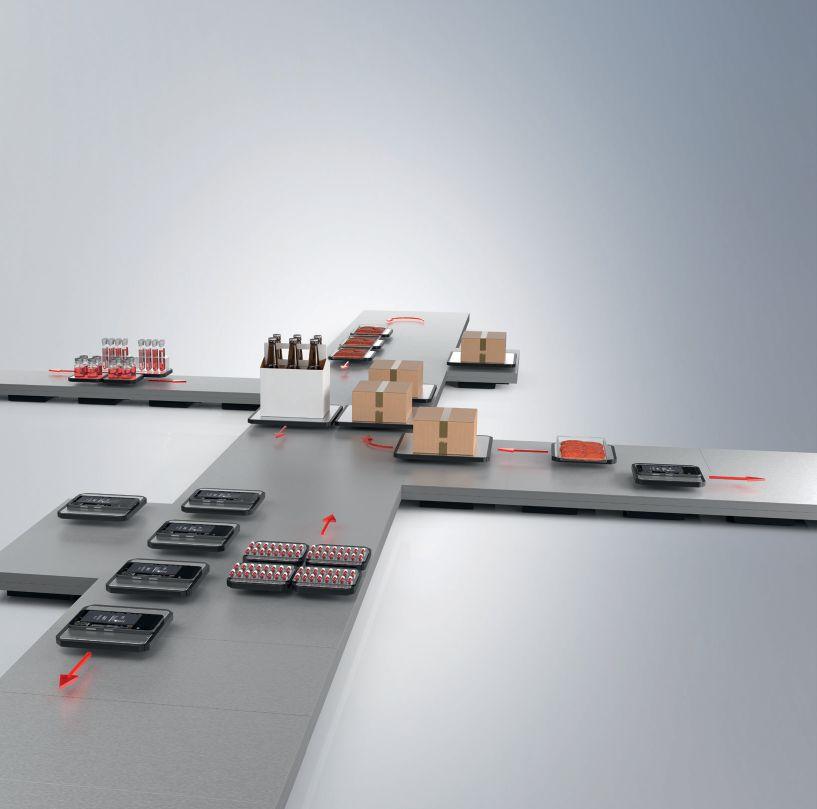

XPlanar enables new dimensions of freedom in product and material handling: Levitating planar movers fly over flexibly arranged planar tiles accommodating nearly any track layout and path planning.
Individual 2D transport at up to 2 m/s
Processing with up to 6 degrees of freedom
Transport and processing in one system
Wear-free, hygienic and easy to clean
Free arrangement of planar tiles enabling totally customized machine and process layouts
Multi-mover control enables parallel and individual product handling
Fully integrated into the powerful and standardized PC-based Beckhoff control system
(TwinCAT, PLC IEC 61131, Motion, Measurement, Machine Learning, Vision, Communication, HMI)
For use across all industries: assembly, packaging, food/bev, pharma, laboratory, entertainment, …
Michal Goc has created a legacy of solving the most challenging automation problems with an innovative mind and constant perseverance.
BY SUKANYA RAY GHOSH
Automation has often had the misfortune of being misunderstood as a segment that takes away jobs. The scope of automation technologies has expanded quite rapidly. Industrial automation, in particular, has redefined job roles and skills required to work in manufacturing facilities today. It has removed the necessity of human beings working in dull, dirty and dangerous environments. It is important to remember, however, that the success of these technologies is dependent on the people who implement and use them every day.
To celebrate trendsetters and legends in the industrial automation space, Manufacturing AUTOMATION introduced the Lifetime Achievement Award this year. The 2023 award goes to Michal Goc, senior controls and














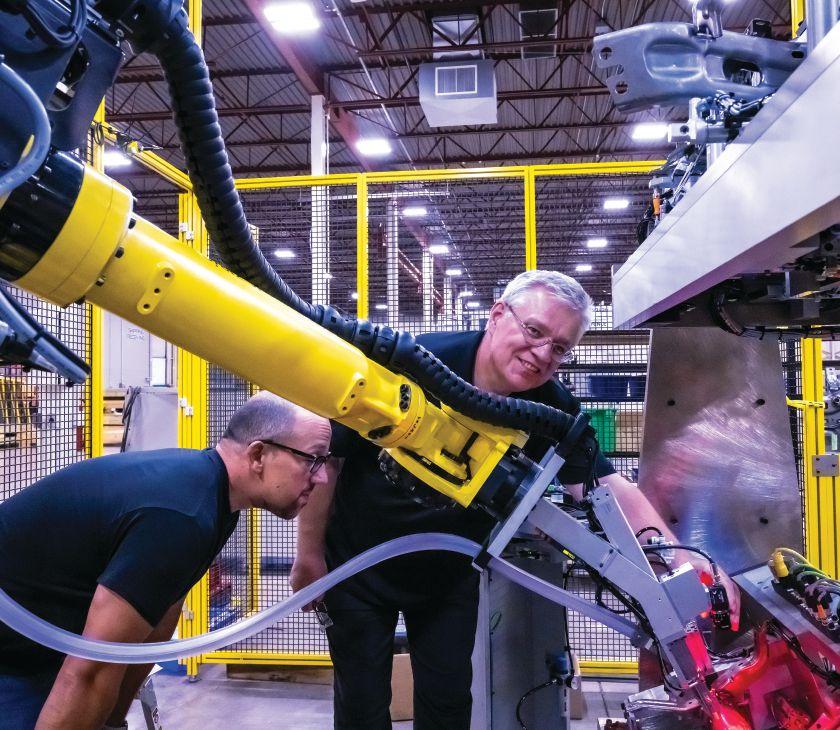
vision integrator at Systematix, a Samuel Automation facility.
“What always fuelled my drive and motivation was when someone told me a task was impossible.”
G oc has been an enthusiastic trailblazer in industrial automation for more than 32 years now. Early in his career, he found his passion for solving problems using innovative machine vision solutions. Over the course of 22 years in this field, he has developed and refined his expertise.
Goc’s enthusiasm and passion for automation can be traced back to his childhood years when automated toys
fascinated him immensely. Even as a child, he often enjoyed tinkering with the toys, adding small controls and motors to make them move.
G oc shares that choosing automation as his career was a no-brainer for him. He graduated in electrical engineering, the closest field of study related to automation that was available at that time. He, thereafter, opted for courses that aligned accordingly. Right out of school, Goc began working in the field of industrial
automation, first in manufacturing facilities in their service departments. He then moved on to engineering firms where he started developing products and engineering solutions and continues to do so even today.
“ What always fuelled my drive and motivation when I was young was when someone told me a task was impossible. I would work really hard on such problems and figure out a way to solve them, make them possible,” says Goc.
T he team at Systematix, where Goc currently works, shares that his skill in solving intricate vision-related problems has been a driving factor in the company’s continuous advancement to solve emerging challenges. His creation of specialized algorithms, including the Flatness Check, Perpendicularity and Parallelism check, and the multi-axis coordinated servo motion control, demonstrates his practical approach to addressing complex issues. These innovations reflect his role in guiding the company over the years to overcome new vision obstacles and keep pushing the boundaries in the field.
Goc’s approach to developing advanced vision solutions is rooted in practicality and innovation.
W hen asked about his most memorable automation projects, he says that there have been too many over the years to pick just one.
He adds, “I have been working for a long time on a vision system for our company called Machine Vision Systematix, or Mavix. This system has created a sort of legacy for Systematix. Many customers come to us just for this vision system. This project really excites me.”
the trajectory and convert the rotational motion of the servo and transition it to some sort of path in a linear motion. That was an exciting project where I was doing calculations for a system which was moved by two servos, but the final motion was on a sinusoidal path. It was supposed to be super-fast, and the servos were just moving the arms and stuff. I get
very excited when there is complicated math involved in a project,” he says.
Another project that involved complex math was where the requirement was to create algorithms to calculate whether the surface was plain or whether the shafts were perpendicular to other surfaces. The algorithms were created using advanced math.

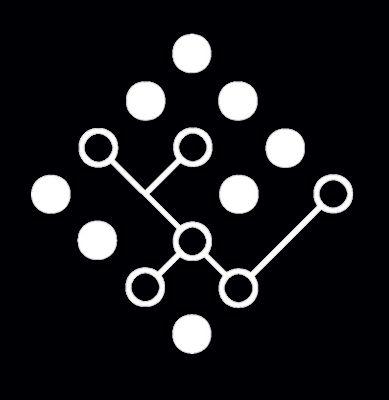




Mavix is a PC-based multicamera vision inspection system that provided the company with its own set of advanced vision solutions for complex applications, giving it a competitive edge in the industry.
Goc’s utilization of artificial intelligence (AI) and deep learning hardware and software adds another layer of sophistication to these solutions, enhancing their capabilities. His expertise also extends to developing custom optics and lighting solutions, showcasing his problem-solving skills.
Goc shares that another memorable automation project was one where the geometry of the motion was complicated.
“I had to use mathematical skills to calculate
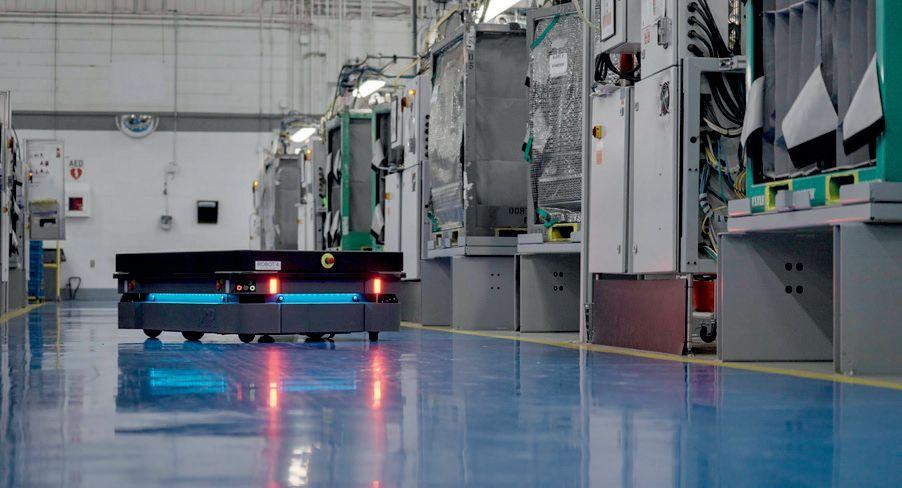
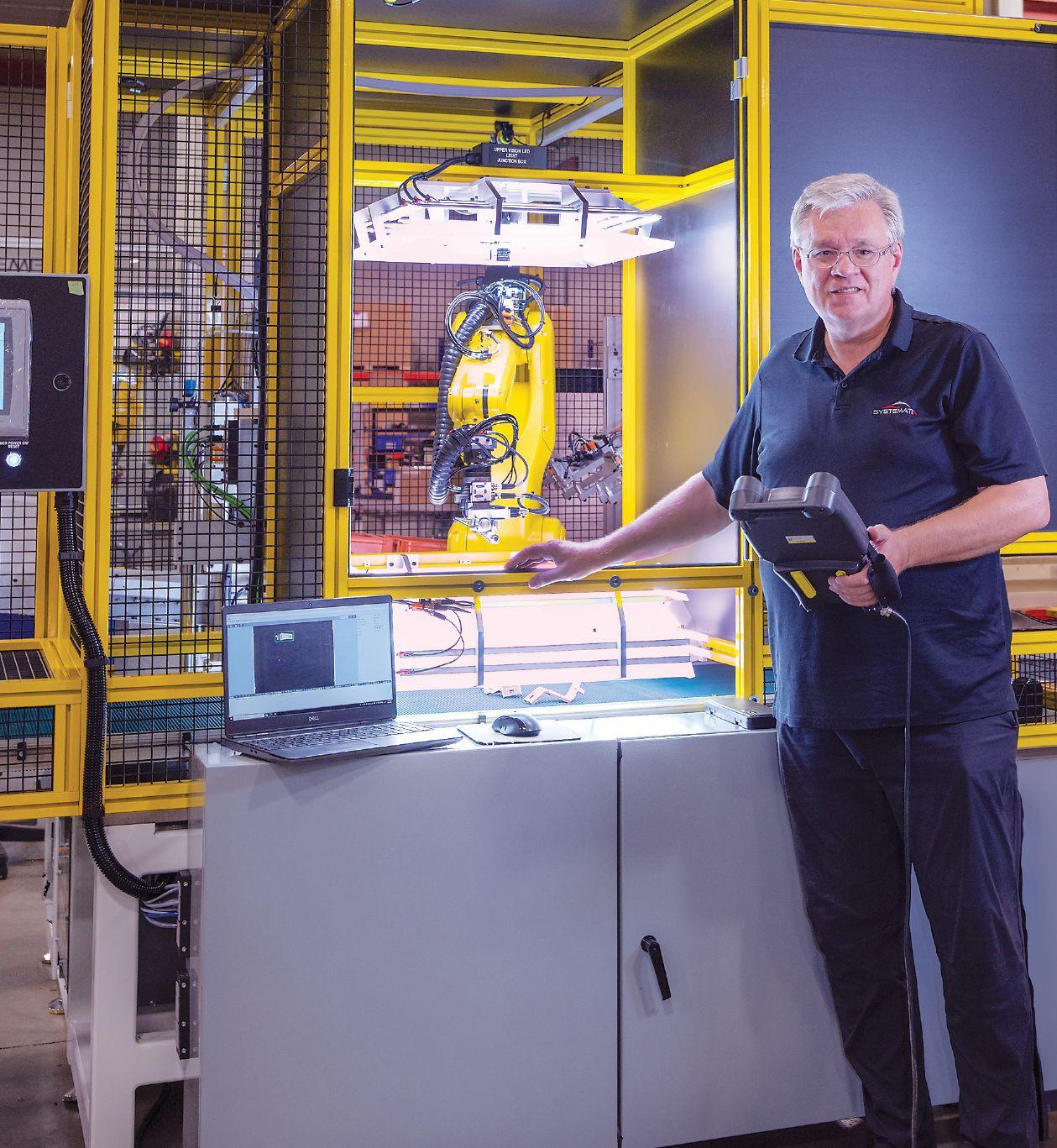
see and do other things more reliably. This turned the previously impossible tasks into possible,” recalls Goc.
He remembers working on a project where it took him about three months to create vision algorithms using classic standard tools. When Goc completed a short course on deep learning and used these algorithms to solve the same problem, it took him two days and produced the same results.
Goc shares that the perception














“In our field, things change very quickly. New technologies are launched multiple times a year. So, you have to be able to learn and explore to identify the best solution.”
be achieved with automation. To understand where the technology is headed in the future, it is important to take a look at what has changed and how, he says.
“It started as a system where you would purchase the different parts and pieces of hardware and put all of them together to create the solution. You would purchase lights, lenses and cameras, configure them on the computer and then program them
-panies developed smart cameras that came in a small box and possessed thechase them in one place and deploy them very quickly. But they also had
oc says that vision cameras today have extremely high resolutions, sometimes as high as 64 megapixels. He adds that he recently worked on a line-scan solution that needed 105 megapixels of camera resolution.tems were unable to support it. The customer-preferred system was only able to go up to 64 megapixels. The customer tried another system but that had communication issues and did not perform well. They even hired expert consultants in this field to try to resolve the issue but to no avail. Eventually, Goc and his teammates at Systematix worked on an in-house software matrix that was able to solve the issue at hand. He feels especially proud of this achievement.
Goc notes that in the near future, he sees the vision segment headed toward even higher resolution cameras. He
adds that the processing power of computers will also develop accordingly to support these advances.
“ There is a demand on optics to support such high-resolution images. Software, combined with AI and deep learning capabilities, will eventually be able to extract the information from the image at high speed and high resolution. We are currently trying to highlight features with different types of lighting scenarios. The technology already exists to do back lighting, dark field lighting, front lighting, bright field lighting, on-axis lighting, diffused lighting, direct lighting and so on, to make it easier for the camera and software to determine what is a good part versus a bad part or to guide a robot. Today, there are attempts to use generic lighting combined with high resolution cameras or cameras from multiple angles to create 3D images and extract features with AI. This allows for a more human-like inspection. This is where the technology is headed,” says Goc.
He adds that there is still a long road ahead for vision systems to reach that level of sophistication. And the market still exists for the smaller vision cameras to solve the simpler problems that manufacturers regularly encounter.
Committed to his craft Goc’s commitment to automation is grounded in practical actions that benefit both Systematix and its clients. His role extends beyond work within the company and for customers. With a hands-on approach to industry improvement, he has even collaborated with Cognex to enhance their vision algorithms.
His contributions go beyond the office, as he offers webinars to customers and shares insights in industry publications, promoting practical knowledge exchange. He also plays a vital role in training the next generation of vision integrators, ensuring the future of skilled professionals.
Goc strives to make the machines work right with his solutions, even when the starting point is frustrating and presents as a Herculean task.
“Even when I’m not able to find a way out, I keep working on the problem till I do. People have now come to believe in me. They trust me to figure out the solution eventually. This is a big achievement for me,” he says.
He adds that when an automation project seems too big, he starts with the small section of the task that he is most familiar with. He has learnt to work his way up slowly, tackling
every challenge as it comes along. It is easy to feel scared when you don’t know the complete solution at the get-go, he says.
To the next generation of professionals entering the automation workforce, he says it is important to have the willingness to learn.
“In our field, things change very quickly. New technologies are launched multiple
times a year. So, you have to be able to learn and explore to identify the best solution. If something works, do not feel satisfied and walk away. Try different approaches to see if there is a better way. Strive for 100 percent results. The automation solution should be good enough to continue performing well for years to come,” he says. | MA


One system for every requirementBurner management with PNOZmulti 2 Burner.
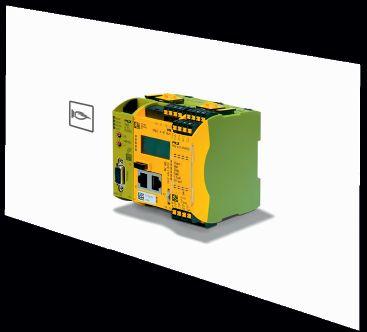

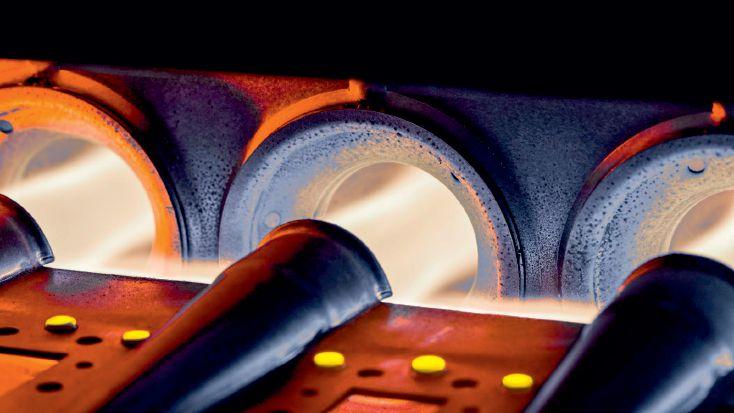


BY SUKANYA RAY GHOSH
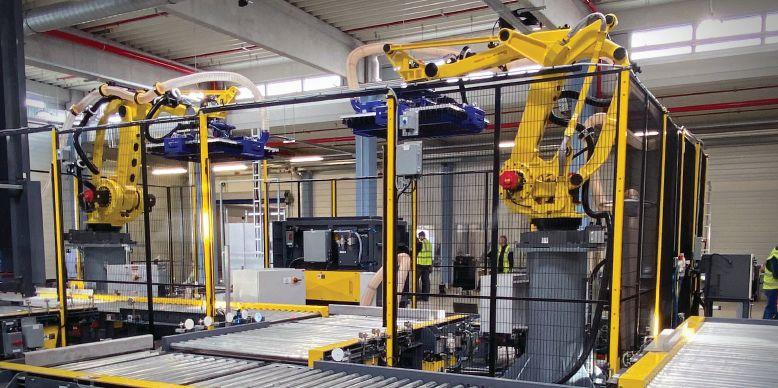
Current robotics technologies have advanced to the point where a wide range of solutions are available for the unique needs of all types and sizes of manufacturers. However, integrating robots into existing production lines is not without its challenges.
Barrie, Ontario-based automation solutions provider Black Controls has expanded its capabilities to offer robotic integration in response to the growing market demand in this space. Matthew Heisz, programming team leader at the company, shares that currently, general part manufacturers most commonly demand robotic material handling or assembly solutions. For example, it could be a robot with a screwdriver, installing screws; picking and placing components and installing them into a larger component. The company also sees a demand for welding applications.
The Black Controls team recently worked on a robotics project for a customer in Scarborough, Ont.
Heisz shares that the customer had a robotic cell connected to an injection molding machine. The system was already implemented but they were encountering issues














with product quality. As per the production process, the part was coming out of the molding machine and then a clip was installed in it. With the existing system, there was an issue with the clip installation. So, the manufacturer requested the Black Controls team to add camera inspection to validate the products. They also asked if it would be possible to make cycle-time improvements and process improvements as the equipment was not the most efficient.
The team immediately jumped into action.
“We went down to their facility along with another supplier and did a feasibility study for the actual inspection. We provided the quote to them. Once we received the job, we did a site visit and made sure that we had the latest programs of it,” says Heisz.
The Black Controls team added the camera and the logic to make it work. They added the routines and extra points to the robot, programming it to stop at the camera inspection position.
While the solution was a simple one, there were some challenges to be addressed during the integration process itself. There were issues with variations in the parts that were being produced. Potential delay between the parts coming out of the mold machine and
being presented to the camera would result in inspection variations that had to be correctly analyzed.
Heisz notes that another challenge was that they weren’t working with machines that they had programmed. “You always struggle with learning other equipment’s program to figure out how best to incorporate your new logic into it,” he says.
He adds, “In the original program the robot profiles weren’t necessarily smooth. There were some opportunities with some handshaking where you had both robots sitting stagnant for longer than necessary or idle when they shouldn’t be. So, we took our time reviewing it, understanding the application, and then implementing the solution.”
The Black Controls team made the machine vision camera implementation a useful process so that the customer would not only see how many times a part failed but also understand which part was in front of the camera when it failed, giving them the means to track and display that information.
After the implementation, not only was the issue with the clip installation resolved, but the customer was also able to be confident that the parts they were producing were good. The was also significant cycle time improvement for one of the part variants.
“We were basically able to take it down to the point where the robots are always ready right as the molding process is finished. Previously, a mold would be sitting open for eight to 10 seconds with no action while the robots were still processing the previous parts,” says Heisz.
A different type of robotics integration project that Black Controls recently worked on is installing automated mobile robots (AMRs) in a facility in Newmarket, Ont.
The ask of the project was to use AMRs to move products to and from the manufacturing facility’s warehouse and production lines. Heisz notes that AMRs were new technology
for the Black Controls team. So, the initial step was to understand how they work. The technology was new territory for the customer too. Both teams had to work together through the implementation process to adapt the systems and make them as simple as possible to meet the customer’s requirements.
Since the AMRS were being used as part of a fleet, the Black Controls team ensured that proper communicating commands to the fleet were in place to call and get the status of the robots. The robots then required programming to accomplish their tasks and interact with the PLC for the system.
Heisz says that while the AMR implementation process was quite straightforward and simple, there were different layers to it that needed to be taken care of.
“We had to connect multiple lines to our PLC, and coordinate pickups and drop offs between the warehouse and the station. There was a significant layer of communication logic that had to be worked through and implemented. All the communications to the fleet were done using an API structure. We
added another piece of software that sat in between to communicate between our PLC and the fleet specifically for this. There was a lot involved in just establishing basic controls before we could develop the process and the application,” explains Heisz.
The manufacturer undertook the AMR project to replace human material handlers who were responsible for bringing the bins from the warehouse to the line. After adding AMRs, the employees could be deployed to do other tasks. In addition, the facility was able to increase throughput per shift. Where the employees were able to move 80 bins per shift, the AMRs managed to move 90 in a shift.
Heisz adds that there was a significant learning curve for the facility’s line workers. While the hand-off with their colleagues was a smooth process, they had to learn how to call the robots and move the bins as needed. They had to learn how the AMRs interacted with the system. The warehouse operators were also trained on how to read the information on the screen and work with the AMR fleet.
Heisz shares that Black Controls did not
provide the robots. “The customer had done a concept trial with an AMR distributor. We came on as the integrator. So, there was a concept in place, with details and expectations on how the AMRs were to function. The implementation process was a team effort where we all worked to figure out which ideas would work and how we should approach things. The distributor was able to support the process as necessary,” he says.
The Black Controls team trained the customer’s line operators, team leads and maintenance staff to ensure that the AMR fleet would run smoothly. “We showed them how to fix the robots and recover them should they get stuck or are not able to manoeuvre. We trained them on how to address communication failures as well,” adds Heisz.
He adds that with any robotics project, there are always challenges like time associated with setting up robots. The integrator must figure out the communication and control structure. The key, he says, is to work with the customer to understand what they need and ensure that the project is a feasible one. | MA



SUKANYA RAY GHOSH
The full potential of additive manufacturing (AM) and 3D printing technologies is yet to be leveraged in Canadian manufacturing facilities. While the concepts are not unfamiliar territory, cost remains a major concern when considering adoption.
However, there are several avenues available with the current versions of AM and 3D printing technology, that can be successfully introduced in manufacturing settings to automate and improve current processes.
The “sticker shock” for many AM and 3D printing options is often a turning-away point for many manufacturers, says Mark Kirby, industry training manager at the University of Waterloo. This cost is especially high in metal additive manufacturing, requiring hundreds of thousands of dollars of investment in a capable printer. Plastic 3D printing can be quite affordable, says Kirby. However, most companies are more comfortable investing in tried and tested automation solutions rather than something completely new and expensive.
Where can manufacturers begin when considering AM and 3D printing? Kirby says it could be with the purchase of a plastic 3D printing machine. They can also purchase components from Canadian suppliers through Canada Makes, a not-forprofit industry organization. Kirby suggests that if a manufacturer is not sure whether an AM solution is available for their unique problem, they can even speak to experts in the field through the Canada Makes website’s “Ask the Experts” feature.














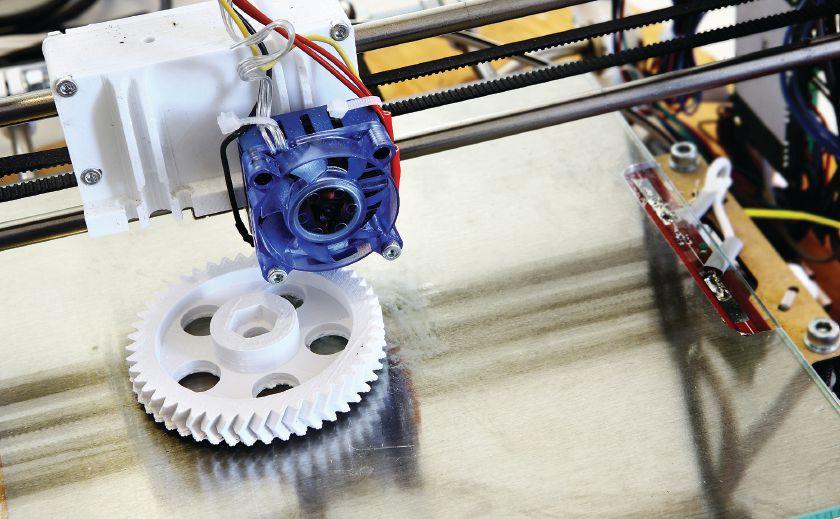
Canada Makes can be used as a onestop solution for getting some parts created.
“Manufacturers should think how 3D printing can initially help the company save money on existing processes that can be controlled,” says Mark Kirby.
“If you had an idea for, maybe 3D printing that would be interesting, but were not really sure where to start, you could explore the area with Canada Makes without being hardsold solutions by vendors,” says Kirby.
Manufacturers can also leverage Next Generation Manufacturing Canada’s (NGen) demonstration program to kick-start the project with initial funding support.
Are AM and 3D printing for everyone? The simple answer is yes, says Kirby. There is some solution available for everyone. However, when a manufacturer expresses an interest in these technologies to solve a problem, the first question he asks is why they are interested in the first place.
“I ask them to describe the problem and the current solution they are using. Typically, they share that they
use some kind of manufacturing process. If they say the current solution is too expensive, and therefore they need 3D printing solutions, I immediately discourage them. AM and 3D printing are not silver bullets that make you more competitive out of the gate just by replacing one process with another. It is not a good place to start; it is a good place to finish the journey, however,” explains Kirby. He adds that manufacturers should think how 3D printing can initially help the company save money on existing processes that can be controlled.
A 3D printing operation needs 3D models. Kirby says that the manufacturer should also consider whether they have in-house knowledge of CAD (Computer-Aided Design) to be able to render 3D models efficiently.
3D printing application
Using 3D printing to manufacture
machine parts is an application that most manufacturers are aware of. The application can in fact expand to include parts of robots, such as end-of-arm tooling like grippers, tool changers, carton erectors and more.
A Canadian company that specializes in this area is Anubis 3D. Tharwat Fouad, founder and president of the company, explains that it is important to understand the different technologies to leverage them properly in a manufacturing setting.
Fused deposition modelling (FDM) is ideal for small-quantity parts production for prototyping and checking the functionality of a particular assembly.
Fouad shares that there are other technologies in plastic 3D printing that manufacturers are not aware of, such as selective laser sintering (SLS).
“SLS can often provide more durable parts and are repeatable in terms of expectations from strength and mechanical properties, than FDM. If you’re a manufacturer, who’s trying to use AM technology to create complex parts that are available quicker, and sometimes perhaps cheaper, you could look at SLS as an alternative,” he says.
Fouad shares that his company uses SLS technology to create and supply end-of-arm tooling for its customers’ production lines. Sometimes, these are standard Anubis 3D products and sometimes the tools are customized to suit the customer’s needs.
This technology is widely accepted now and considered advantageous over
traditional tools, says Fouad.
“One of the main drivers for 3D printed end-of-arm tooling is the collaborative robot space. Collaborative robots require lightweight tools because the payload capacities are limited. Also, these tools need to have some soft features and have certain safety requirements. With a 3D printed tool, we can address those needs much easier than traditional tools,” he explains.
As an example, surface grippers are mounted on robots to pick boxes. With 3D printed options, the grippers can have rounded edges instead of sharp corners. Fouad notes that if someone accidentally hits a metal equivalent, it can hurt them.
Recounting a success story, Fouad shares that they recently converted a company that was using regular surface grippers to 100 percent 3D printed end-of-arm tools. “They were using grippers from a company in France. They converted to 3D printed tools because they now have the flexibility of adding suction cups wherever they want. They also integrated a tool changer as it adds value during changeovers and maintenance. The 3D printed tools are lighter, and they get delivered faster when compared to importing grippers from France.”
NGen’s AM demonstration program is designed to help manufacturers realize the potential of AM technology and identify implementation risks at an early stage.
Frank Defalco, director of member relations and the AM demo program administrator, shares that NGen identifies small- and medium-sized manufacturers and OEMs from within its membership or from referrals from IRAP ITAs that are eligible to participate.
“I set up a meeting with them to determine where they are in their AM journey. This is important because there are myriad reasons why the company is investigating this technology. I ask about their goal. For NGen, the goal is to identify how AM could be a production tool. Sometimes the manufacturers really understand the technology while some manufacturers are very new to it,” explains Defalco.
Defalco and the NGen team help manufacturers identify the most suitable technology and service providers based on their ability to meet AM objectives. The association also facilitates conversations between companies and service providers to ensure that the projects are successful.
“Target the processes instead of parts because you can nearly always find good applications for 3D printing somewhere in the manufacturing process. You will learn a lot. And if it helps you make your parts more efficiently, then you’ve got a return on the investment but you’ve also critically developed knowledge now that you can use for competitive advanced 3D printing. You will use the technology more intelligently,” says Kirby. | MA
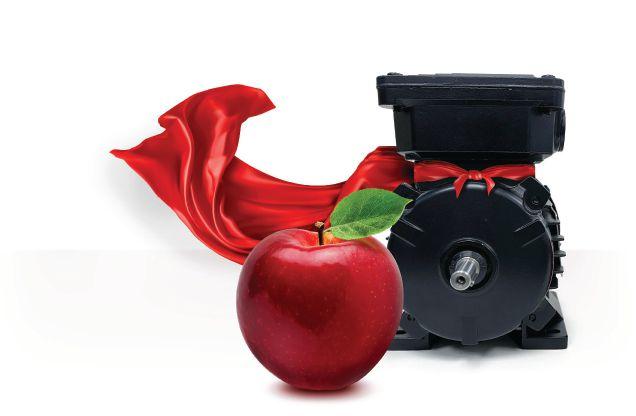
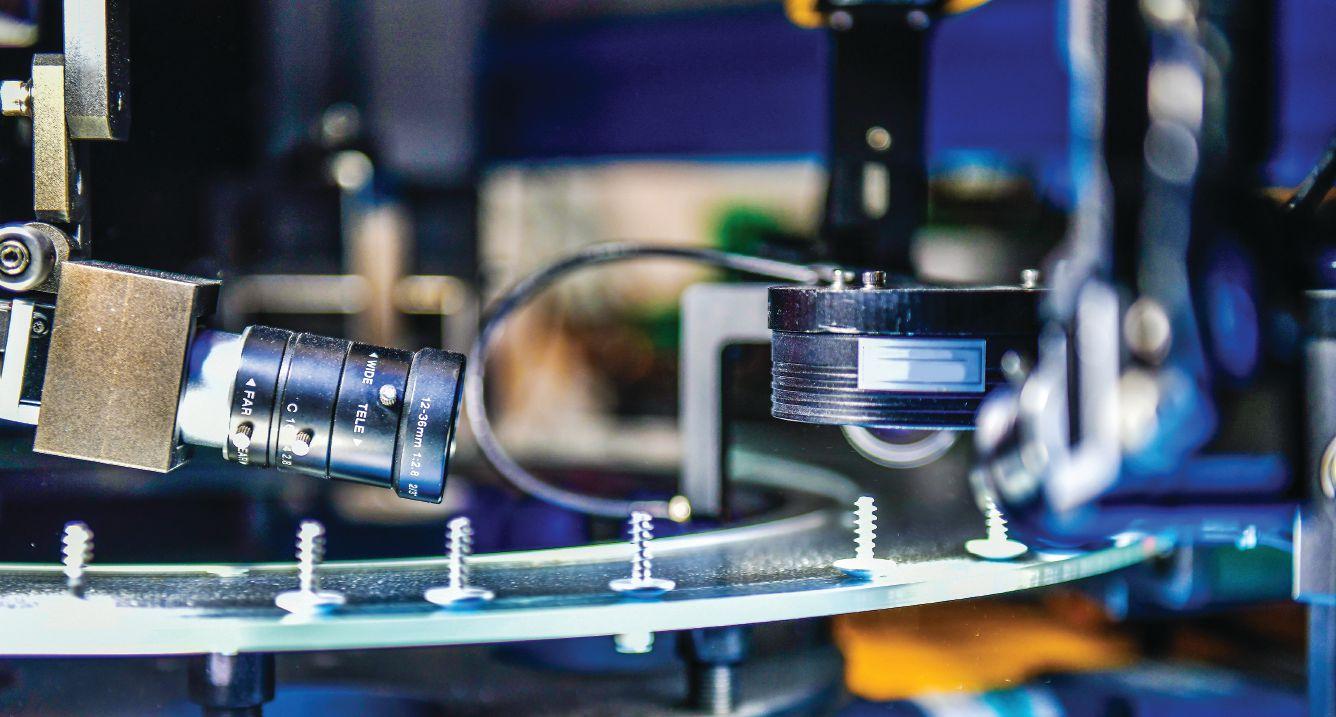
BY SUKANYA RAY GHOSH
Implementing agile manufacturing production processes with Industry 4.0 technologies can be a transformative endeavour for small and medium sized manufacturers (SMEs). Agile manufacturing places a strong emphasis on responding rapidly to the ever-changing customer demands. In a market that is highly competitive, reacting quickly and intelligently to market conditions can prove to be a game changer for SMEs.
Jonathan Weiss, CRO of Eigen Innovations, says that meeting the ever-changing landscape of demand is one of the most important challenges for all manufacturers, whether big or small. “I see the most value for manufacturers coming from the tools that can help augment and complement people in the workplace. It’s not uncommon to hear about how technology is going to take jobs away from people in manufacturing facilities, but I don’t really see it that way. I see technologies augmenting skills that have either left the workforce and














have not re-entered, or as tools to help folks upskill into new types of roles,” he says.
Yassir Rizwan, co-founder and CEO of Labforge, explains that SMEs often tend to rely on older processes. Although they are aware of technologies like machine vision and artificial intelligence (AI), these are not on their priority list. “They have existential fires happening and need to put out these fires first. For example, labour is expensive. Raw materials are expensive. They have competition from abroad. Shipping products is expensive. So, unless vision systems or AI are going to affect their core processes or the core priority items, they are low on their task list,” he says.
Rizwan adds that when SMEs can take the time to do deep dive and add some kind of automation at their facilities, they are able to gain quality improvement and consistency of their products, along with labour saving and increased throughput.
For example, says Rizwan, if a small bread
manufacturer producing 200 loaves of bread per day were to consider adds a vision camera system to check the bread colour, it can ensure consistent taste of its products.
Implementing machine vision and AI technologies can be expensive. SMEs often struggle to allocate the necessary funds for hardware, software and skilled personnel to projects that are not critical for their survival. It is crucial, in such circumstances, to start by identifying specific pain points or areas where agility is crucial in their production processes. There is a need to define clear objectives for implementing AI and machine vision technologies, such as improving quality, reducing downtime or increasing production speed.
Rizwan shares that while vision and AI can indeed help SMEs respond quickly to market and customer demands, these technologies have a high barrier to entry. “The biggest problem is there’s a learning curve. There’s a
lot of jargon, usually industry terminology that people don’t understand and terminology that people often get defensive about. And understandably so, because the industry is moving very fast. Keeping up with AI technology is a limitation for small manufacturers. It turns out that AI and machine vision experts also cannot keep up with all the advancements in this field, they can only focus on their own sub-fields,” he explains.
He adds that without the presence of inhouse expertise, technology can turn into a bane rather than a blessing. For example, he says, a manufacturer adds machine vision and cameras with the help of an external expert to perform a specific task like identifying product consistency. However, two months down the road, the customer demand changes and there is a need to alter the product slightly. The manufacturer has to ensure that the camera is now checking for consistency of the altered product.
“So, the question for the manufacturer is do they modify the requirements on their own or do they spend the extra and get an expert? I think the answer to this going forward is going to be tools that are easy enough for manufacturers to use themselves and modify themselves. The key is to give them the tools to make those small changes themselves rather than having to go back to the experts and re-integrate everything and redo everything. Most tools currently in the market are not like that. They’re tools targeted towards experts,” explains Rizwan.
Automated quality control of products is one of the many ways in which SMEs can ensure a quicker response to changing market conditions using vision and AI technologies. These technologies can help them forecast demand and optimize their supply chains. For companies that do not have surplus funds, these small changes can go a long way in ensuring long-time survival.
Hugues Foltz, executive vice-president of Vooban, says that for SMEs, AI, for instance can not just optimize the production processes, it can even optimize the scheduling of all production.
“For example, even if it’s a new product, there’re always sub-assemblies that can be reordered and rescheduled in a better way than just taking a new product that is in demand and put it in line as ‘first-in first-out’, which is not productive at all. Those processes can be optimized using operational research by
looking at the best formula and the best recipe to achieve the same task,” he says.
Foltz explains that this is similar to using Google Maps to figure out the best route to reach a destination while factoring in distance, traffic, road closures and so on.
With limited resources on hand, SMEs need to be armed with all the right tools to
stay ahead of the game. AI can be a major game changer here, shares Foltz. How can this technology help SMEs react rapidly to customer demands? Foltz says that AI can help predict sales, prepare for the changes and allocate manpower to the production processes accordingly. AI can also help manage stock and inventory as per the
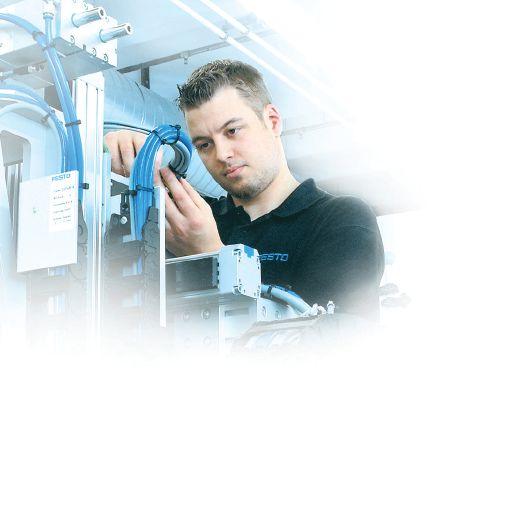

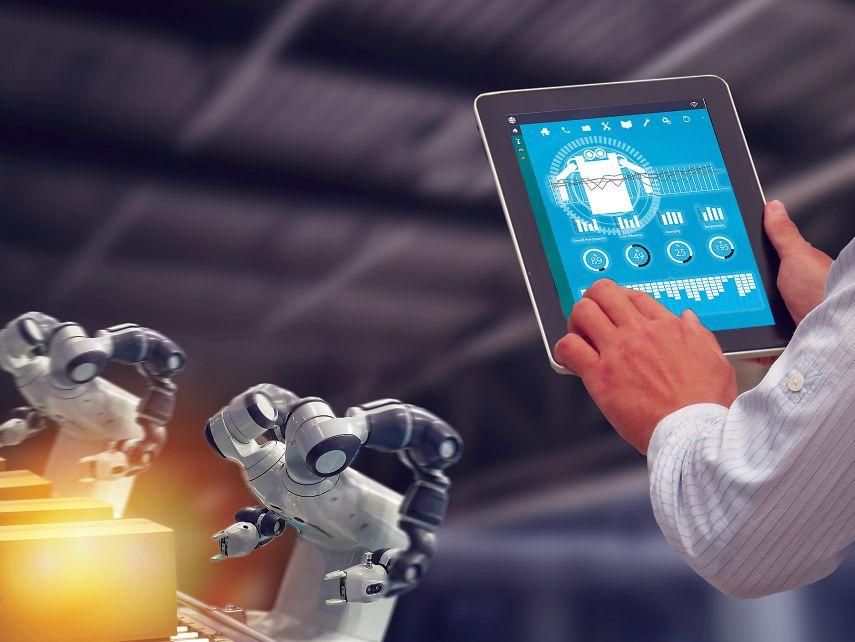
most current requirement.
“ The right prediction depends on the market and the industry. In general, with the right data available from government reports, industry representatives and industry associations, small and medium sized manufacturers can predict when there will be a rise in demand in each market, even a year in advance in some cases. Using AI, they can react to the market conditions. Those predictions can come in 80 percent accurate almost a year in advance,” says Foltz.
He adds that while AI is a very powerful tool, SMEs will need additional information such as two years of sales history of the company, industry trends, market variables and so on. “We can train an algorithm to predict the future easily based on this,” he says.
M any manufacturers today work in a high-volume or low-volume production environment with high variability, where the same products are not produced week after week.
Weiss explains that it can be challenging to understand the changing products and making them to the highest quality standards possible.














Eigen Innovations, which specializes in machine vision systems and software, can help SMEs compare the products they make to their CAD model rendering, for example, thus helping them make real-time decisions regarding the quality of the parts.
In addition, Weiss emphasizes the importance of interoperability of all tooling so that technology additions and changes to the production lines are quicker. Interoperability also enables manufacturers to automate actions and processes based on quality indicators.
“You might need to make a significant change in production, whether you’re reconfiguring lines or you’re introducing new SKUs, new product configurations and so on. There are a lot of changes that need to be made. MES systems change. SCADA systems get new parameters. SPC or statistical process control and tooling changes happen. With your vision systems, you are looking at the new products. So, what does that mean? You need new machine learning models so the cameras know what they’re seeing. Interoperability of the tooling is needed so that your camera system, for example, is not on an isolated island where it requires a tremendous amount of dedicated support to
adapt to the other processes that are evolving,” explains Weiss.
He adds that when adding Eigen’s vision systems at manufacturing facilities, the team, has integrated the technology with MES systems, PLCs and control networks, among other things.
“ Fundamentally, you only get a certain level of value when you’re informed about a defect. You get exponentially more value out of the system when you can actually do some closed loop automation, such as taking the bad products off the line or do ing something autonomous to prevent a customer from getting a bad product,” explains Weiss.
He says that with the kind of agility needed in today’s manufacturing environment, interoperability is required to be able to adapt.
Examples of how SMEs have been able to adapt to the market with AI, vision and other Industry 4.0 technologies abound.
Foltz shares how Stove Builder International (SBI), a manufacturer of stoves and furnaces in Canada, implemented AI to its advantage. SBI, according to Vooban, had invested significantly in automation already before they approached Vooban. They wanted to implement AI.
“The first project they had in mind was sales prediction. Sales prediction is a very good quick win in many cases. SBI had a seasonality challenge. During peak seasons, it often had to manage the impact of labour shortage on its business. SBI needed to produce more products for a few months to fill inventory to appropriate levels,” explains Foltz.
He adds that this issue added to the cost for the company. With a good sales prediction algorithm, Foltz’s team managed to bring to them enough information and enough confidence in what they were going to sell the next year. This prediction would allow them to carry on production at the same pace all year long. The payback, says Foltz, was instantaneous.
“Implementing AI ensured that they are not in firefighting mode during the peak season when customer demand is high. This makes life easier for everyone,” notes Foltz.
For SMEs, every win counts, every success matters. Industry 4.0 technologies available today can be crucial in helping them tackle changing demands quickly with compromising on the quality of their products. | MA
Midsize autonomous mobile robot

OTTO Motors’s newest AMR, OTTO 600 is a reportedly tough and nimble AMR in its class. OTTO 600 unlocks new workflows with its ability to move pallets, carts and other payloads up to 600 kg (1,322 lb). The AMR features an all-metal construction and IP54 rating, OTTO 600 and is built to deliver results in demanding factory environments. The AMR is capable of moving carts and pallets, as well as connecting islands of automation. Key specs include Key specs: 600 kgpayload capacity, 2 m/s maximum speed, 1050/700/320 mm footprint and IP54 rating. OTTO 600 reportedly works safely alongside people because of its advanced sensors and OTTO’s autonomy software. ottomotors.com
Setting own weld path

TRUMPF’s new robot uses sensors to program its own weld path. The robot makes use of TRUMPF’s new smart seam-tracking technology, which the high-tech company developed in collaboration with the Fraunhofer Institute
for Manufacturing Engineering and Automation IPA. The user has to place the welding robot in the start position, and the technology takes care of the rest. The robot uses the sensor to determine the weld path automatically. The system software calculates the weld spots and creates the welding program for the respective part. The robot’s ability to automatically correct its weld path makes the whole process reportedly more stable. It also simplifies the task of handling tighter tolerances and dealing with warping or distortion. trumpf.com

Omron Automation’s F440
Smart Camera is designed to add flexibility to machine vision applications. It serves a wide range of applications, including cap inspection, fill level inspection, box count, label barcode & OCR, measurement, and more. To ensure maximum customization, it offers a variety of accessory options, allowing users to select their preferred lensing, lighting, and cabling solutions. With an industry-standard C Lens Mount, users can fine-tune the optics and lighting to meet their specific requirements. It comes equipped with the AutoVISION software platform. Other features include – 5MP Sony Pregius IMX264 Global Shutter CMOS sensor and compact
form factor (measuring 40 x 61mm).
automation.omron.com
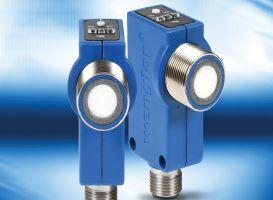
AutomationDirect has added the new Wenglor OPT series cylindrical and rectangular ultrasonic sensors. These new sensors, available in diffuse and through-beam sensing styles, offer sensing distances up to 2000mm, rugged stainless steel and plastic housings, and protection ratings up to IP68 for use in challenging industrial environments. Wenglor ultrasonic sensors are IO-Link v1.1 compatible, offering advanced configuration options such as through-beam, synchronous, and mute operating modes, window teach-in, and external
temperature compensation. These sensors are reportedly are UL listed, CE marked, and RoHS compliant. automationdirect.com

Festo’s Pneumatic Essentials program is a global undertaking to streamline ordering of in-stock pneumatic components. It is reportedly a one-stop-shop for the 16 fundamental components that Festo finds fit most common pneumatic applications. These components include air preparation, high wear polyurethane tubing, one-way flow control valve, high flow valves for normal and harsh environments, self-teaching proximity switch, mini slide, guided drive, direct interchangeability ANSI NFPA cylinders, and metric and imperial round and compact cylinders. festo.com
BY STEPHANIE HOLKO
Since the 1950s, computing has revolutionized manufacturing. Early computing, like Computer Numerical Control (CNC), aimed to enhance machining quality and productivity. These computers were large, cost a lot of money and were used for a specific, limited purpose. They needed specialized expertise and new components. Quantum computing today resembles this nascent stage, but its potential for the next 70 years is immense.
Beginning with CNC machining in the 1950s and 60s, industrial automation took its first strides with computing. What followed was computer-aided design (CAD) and computer-aided manufacturing (CAM). These new tools made digital versions of products, parts and machines, allowed for better communications between design teams and production, and improved accuracy and reproducibility. Industry 3.0 emerged with process control systems, robotics and enterprise resource planning (ERP) systems in the 1970s through the 1990s. As computing technology evolved, more economically viable tools emerged, leading to the integration of simulation, mode lling, automation, internet connectivity and artificial intelligence into manufacturing processes.
While quantum materials and sensors have been around for a while, quantum computing as a part of manufacturing is in its infancy. It is a fundamentally different method of processing data from classical computing. Instead of the binary ones and







Stephanie Holko is the director of project development at Next Generation Manufacturing Canada (NGen). She loves connecting emerging technologies with existing manufacturing problems and believes the future of manufacturing is in the adoption of new ways of working. Stephanie is a licensed Professional Engineer in Ontario.

zeros we are familiar with, it can process many calculations simultaneously. This potential promises to address previously insurmountable challenges in modeling, simulation, materials discovery, and optimization within the next decade.
The approach to complex problem-solving will change with the adoption of quantum computing, analogous to the computation difference from 70 years ago to today. For example, materials discovery has shifted to simulation built on existing data and extrapolation of preferrable properties in new materials.
Quantum computing is eventually expected to take compute-heavy calculations down to seconds or less. The ability of a quantum computer to solve problems that no classical computer can solve in a reasonable amount of time is known as “quantum advantage.” While there are very few examples of quantum advantage that have been demonstrated to date,
more are sure to come.
There are good reasons to consider quantum computing as part of your long-range strategy, including risk mitigation. Most prevalent are the cybersecurity risks that could impact encryption on existing data systems. While some operation technology systems are separated from information systems by the so-called demilitarized zone in the classic Purdue architecture, the Internet of things and other architectures could be impacted by encryption-breaking technologies enabled by quantum computing.
On the flip side, there are many applications that are expected to solve more complex problems that are treated as the cost of doing business today because it is too complex to address. For example, quantum computing could positively impact industrial performance by helping to solve heady problems like optimizing logistics in a larger-scale network or supply chain.
Challenges to deploying quantum computing in an industrial setting include the reliability of the results from current quantum computers and the scalability of quantum computing to the level required by industry. Every day there are developments to mitigate errors in program outcomes and to develop quantum computers with more capacity and accessibility
There are also societal impacts to consider, as with any breakthrough technology. Access to technology by smaller companies and access to training for employees and underserved communities will be important to consider as quantum gains traction. There are ethical considerations in ensuring data bias does not amplify inequities, similar to the concerns with artificial intelligence. Developing quantum technologies while considering the environmental impact – not just of data processing, but of manufacturing and running quantum computers – will be important as well.
Canada is a leader in quantum technologies and has published a National Quantum Strategy to strengthen this advantage. Canadian manufacturers are uniquely positioned to engage with Canadian quantum technologies and to become specialty suppliers to the quantum hardware industry. There is a recently announced funding to support the commercialization of technologies in quantum computing as well as quantum sensing and quantum communications.
Visit https://quantumadvantage.ngen.ca to learn more. | MA
Have company news, case studies, events or story ideas to share? Send to srayghosh@annexbusinessmedia.com and you could be featured in Manufacturing AUTOMATION!







